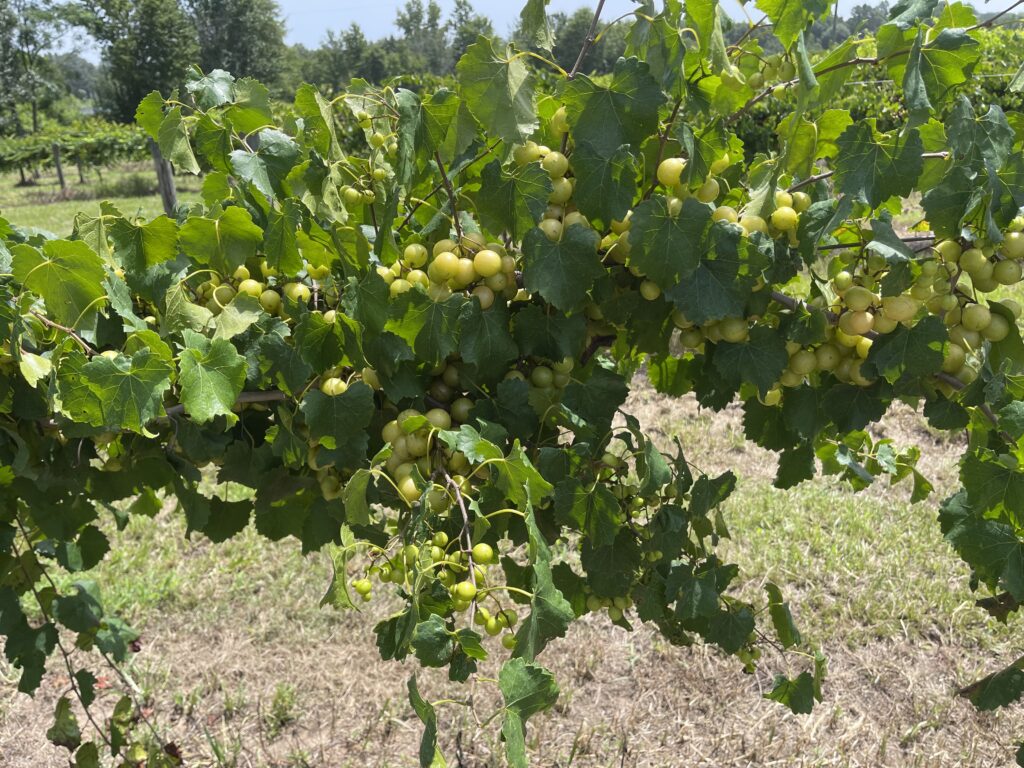Muscadine Plant Spacing
Our recommended trellis systems have evolved over the past 50 years. Our first vineyards were planted using the Geneva Double Curtain. Most vineyards that were planted in the 1970’s-mid 1980’s used this trellis. Typical spacing would be 20 ft between plants and row spacing was either 12 or 14 ft apart. By having multiple arms, the vines would produce more fruit and higher yields per plant could be achieved. The downside of the Geneva Double Curtain was that it was more expensive to install with the crossarms and added wire, trellising the vines could be more challenging, winter pruning was more difficult, harvesting was more difficult, and there was less airflow and sunlight that could lead to more disease pressure on wet springs and summers.
Automation gave way to the single wire trellis system. With tractor mounted mechanical pruners and harvest machines the single wire system made the automated work less challenging, and farmers were able to eliminate costly hand labor.
The recommended spacing was 12 ft between rows and 20 ft between plants. From muscadine breeding efforts, the cultivar selections for fresh fruit varieties have given way to larger fruit, larger self-fertile varieties, and more productive varieties. The increase in berry size and production per plant has reopened the debate on what is the best plant spacing to achieve maximum production while keeping the health of the plant and fruit quality at an optimal level.
In our vineyards we are at the 20 ft plant spacing and 12-foot row spacing. Over the years we have noticed that at the 8,9, or 10 ft mark there would be an imbalance of fruit verses leaf canopy. Fruit would generally be more exposed to direct sunlight leading to sun scald or there would not be enough leaves and vegetative growth to ripen the fruit properly.
Below are some photos taken this year, showing fruit that is produced further down the wire with less canopy.




Over the last few years, we have played with different plant spacing to maximize production and maintain high quality fruit and optimal vine health. The spacing that we feel achieves the above-mentioned goals is 12 ft row spacing and 16 ft plant spacing. In our observations, the leaf canopy stays consistent throughout the entire length of the main arm and provides enough foliage to properly ripen the fruit while maintaining good fruit size.
In yield trials, there was a slight decrease in pounds per plant, but the increase in fruit size (less fruit per plant generally leads to an increase in fruit size) made the difference marginal. The biggest advantage of the 16 ft plant spacing is decreasing the chance of over production that can lead to vine stress, which can ultimately lead to cold injury during the dormant season.
Below is a short video of a row where the plant spacing is 16 ft apart, notice how there is not a block of fruit with no canopy at the ends of the cordons.
Moving forward, our recommended plant spacing will be 12 ft between rows and 16 ft between plants.
In closing, I have enjoyed seeing all the pictures of fruit and vineyards customers share directly with us or on social media platforms.
Greg Ison
Ison’s Nursery & Vineyard







